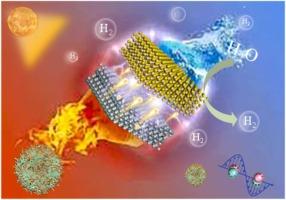通过缺陷介导的内置电场和 LSPR 效应巧妙促进电荷分离,从而提高光催化活性
IF 17.1
1区 材料科学
Q1 CHEMISTRY, PHYSICAL
引用次数: 0
摘要
新兴的s型异质结构在控制电荷转移和维持氧化还原能力方面具有明显的优势。然而,电荷分离效率仍然不是最优的,主要是由于电荷转移的驱动力较弱。本研究构建了一种新型等离子体S-scheme MoO3-x/CdS异质结,促进电荷分离,促进H2的演化,体现了“一石二鸟”的理念。MoO3-x中的富氧空位是这种双重增强的原因之一。首先,氧空位增强了内部电场(IEF),从而加速了电荷转移动力学。其次,它增强了局部表面等离子体共振(LSPR)效应,提高了高反应温度下的催化活性。该策略通过lspr辅助的S-scheme电荷转移途径成功地实现了有效的电荷分离,使CdS导带中的长寿命电子有助于H2的演化。结果表明,优化后的MoO3-x/CdS异质结在可见光和全光谱下的H2析出速率分别为19.85和54.04 mmol·g−1·h−1。利用缺陷协同效应来调节s型异质结构中的IEF和光热效应的概念为合理设计高性能光催化剂提供了一种有前途的策略。本文章由计算机程序翻译,如有差异,请以英文原文为准。

Skillful promotion of charge separation via defect-mediated built-in electric field and LSPR effect for enhanced photocatalytic activity
Emerging S-scheme heterostructures offer distinct advantages in controlling charge transfer and maintaining redox capabilities. However, charge separation efficiency remains suboptimal, primarily due to the weak driving force for charge transfer. In this study, a novel plasmonic S-scheme MoO3-x/CdS heterojunction was built to promote charge separation and enhance H2 evolution, embodying the concept of “Two Birds with One Stone”. The rich oxygen vacancy in MoO3-x serves as the one to this dual enhancement. First, the oxygen vacancy intensifies the internal electric field (IEF), thereby accelerating charge transfer kinetics. Second, it enhances the localized surface plasmonic resonance (LSPR) effect, boosting catalytic activity at high reaction temperatures. This strategy successfully achieves efficient charge separation through an LSPR-assisted S-scheme charge-transfer pathway, enabling long-lived electrons in the conduction band of CdS to contribute to H2 evolution. As a result, the optimized MoO3-x/CdS heterojunction demonstrates optimal H2 evolution rates of 19.85 and 54.04 mmol·g−1·h−1 under visible light and full-spectrum irradiation, respectively. The concept of exploiting defect synergy to tune the IEF and photothermal effects in S-scheme heterostructures presents a promising strategy for the rational design of high-performance photocatalysts.
求助全文
通过发布文献求助,成功后即可免费获取论文全文。
去求助
来源期刊

Nano Energy
CHEMISTRY, PHYSICAL-NANOSCIENCE & NANOTECHNOLOGY
CiteScore
30.30
自引率
7.40%
发文量
1207
审稿时长
23 days
期刊介绍:
Nano Energy is a multidisciplinary, rapid-publication forum of original peer-reviewed contributions on the science and engineering of nanomaterials and nanodevices used in all forms of energy harvesting, conversion, storage, utilization and policy. Through its mixture of articles, reviews, communications, research news, and information on key developments, Nano Energy provides a comprehensive coverage of this exciting and dynamic field which joins nanoscience and nanotechnology with energy science. The journal is relevant to all those who are interested in nanomaterials solutions to the energy problem.
Nano Energy publishes original experimental and theoretical research on all aspects of energy-related research which utilizes nanomaterials and nanotechnology. Manuscripts of four types are considered: review articles which inform readers of the latest research and advances in energy science; rapid communications which feature exciting research breakthroughs in the field; full-length articles which report comprehensive research developments; and news and opinions which comment on topical issues or express views on the developments in related fields.
 求助内容:
求助内容: 应助结果提醒方式:
应助结果提醒方式:


